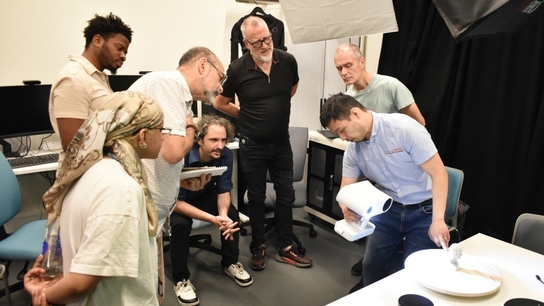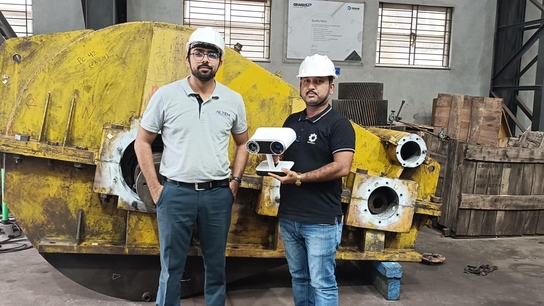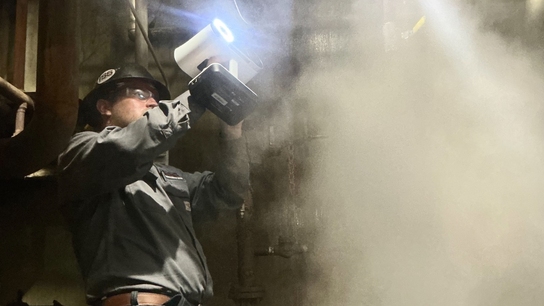Using Artec Space Spider in viticulture: scanning grape bunches to help fight grapevine disease
The Goal: To use a handheld 3D scanner to capture bunches of grapes growing onsite, on the vine, and create 3D point clouds of the bunches, for scientists to then analyze and extract information from.
Tool Used: Artec Space Spider
Viticulture, a science that the Athenian historian Thucydides claimed to have had a civilizing effect, may not be the most expected field of study to apply Artec 3D solutions to.
Viticulture, a science that the Athenian historian Thucydides claimed to have had a civilizing effect, may not be the most expected field of study to apply Artec 3D solutions to. Yet grape cultivation stands to gain enormously from using them, as a group of researchers has shown recently in their article. Published March 2018 in the journal Sensors, the researchers’ study grapples with the issue of fungal diseases or “bunch rot.” It is known that bunch rot can often lead to infestations, which result in damaged crops and diminished yields. Researchers from the Institute for Grapevine Breeding Geilweilerhof and University of Bonn joined forces in this research to develop an innovative image-based analysis method with the goal of helping to reduce bunch rot and improve grapevine selection for breeding purposes.
Instrumental in their approach was Artec 3D’s very own Space Spider 3D scanner.
During their experiment, researchers discovered that using Space Spider to create visualizations of grape bunches could help significantly speed up statistical assessment of plant characteristics when compared to existing methods. Based on blue LED structured light technology, Artec Space Spider is a user-friendly, fast, and powerful 3D scanning device that generates rich, high-res digital images. Used in a multitude of industries, it can capture a wide array of complex geometries, textures, and colors with a 3D point accuracy of up to 0.05 mm. Weighing at just under two pounds, this extremely lightweight 3D scanner performs equally well in the lab as out in the field. This made it ideally suited for the range of scanning contexts devised by the researchers of the study.

In their paper, the authors of the study immediately recognize the correlation between “bunch compactness” and risk for bunch rot. Likewise, other studies have previously confirmed that the denser the grapevines, the likelier that infestations will occur. Indeed, many grape growers have also reached a similar conclusion, which fundamentally underlies their preference for breeding and cultivating grapes that have a looser bunch structure.
When considered in a broader economic framework, eliminating bunch compactness could only make good business sense, as heightened chances for crop infestation due to bunch rot can prove detrimental. After all, as the present study proclaims in its opening pages, “Grapevine (Vitis vinifera L. subsp. Vinifera) is one of the most profitable crops worldwide.”
But, from a viticulturalist perspective, preventing bunch compactness is no easy task.
First, the physical composition of grapevines is dauntingly complex and varied. It requires grape growers to take scrupulous note of seemingly countless physical traits that are rooted in the unique genetic structure of each grapevine. Second, given a grapevine’s “mosaic” composition, a single bunch alone can generate huge volumes of data, detailing information such as the amount, size, and age of the grapes. The International Organization for Vine and Wine even publishes a point system for classifying vine morphology based on a set of characteristics. Nevertheless, this kind of score-based method demands a disproportionate amount of time and human resources. And perhaps least desirable of all is that the data it produces ultimately is subjective and error-filled, according to authors of the study.

Grape bunches used in this study for data acquisition and parameter extraction
By contrast, Artec 3D’s Space Spider offers an exponentially more effective and objective approach to assessing grapevine architecture. In the lab, researchers of the study used Space Spider to capture images of 10 table grapes. The scanning process was performed 10 times under different rotation speeds. This enabled researchers to validate the accuracy of Space Spider’s data output, as the differing speeds of rotation would generate different point densities. When Space Spider finished reproducing the 3D point cloud of the bunches, researchers set out to analyze the data using 3D-Bunch-Tool, a software application designed to extract information about grape bunches, such the size and quantity of berries.
The 3D-Bunch-Tool, otherwise known as “3D-BT,” is based on a modified algorithm. Its workflow involves three steps. First, the high-res point cloud is reduced down as part of the pre-processing step, which helps cut down on computing time. Second, the points of the cloud undergo segmentation by “regions,” each of which is generally limited to the area of a single grape. And finally, a RANSAC-based approach is utilized to construct sphere models based on the data. The digitized visualization of the grape bunch can then be adjusted in the finalization stage.

Graphical User Interface (GUI) of 3D-Bunch-Tool (3D-BT)
After the researchers ran 3D-BT on the point cloud data that Space Spider had generated, the 3D trait data were then cross-checked with ground truth data. The researchers made a positive finding during this stage of the experiment, indicating that this statistical comparison yielded very high correlation values across the data sets. This meant that there were only very small differences detected between the 3D data and real-world data.
Significantly, the researchers also point out the potential cost- and time-saving benefits of this 3D scanning method. In comparing approaches to grapevine trait assessment, they posit, “According to the size of the bunch and the total number of berries, the whole procedure [where other methods are used] needs on average 10 min per bunch. Thus it is very labor-intensive and invasive. In comparison, acquisition of point clouds by using Artec Spider and data storage, need [sic] on average one minute and therefore this represents an up to 10-times faster, robust and non-invasive method. In addition, it enables the investigation of the bunch architecture in its natural 3D structure.”
The researchers further underscored that, while image-based approaches to obtaining 3D point clouds have long existed, they often required the use of exorbitantly priced laser technology and involved the application of invasive techniques. Naturally, their high costs and limitations diminished their appeal to researchers. This why they turned to Artec 3D’s imaging solutions. In particular, they applaud Space Spider for its versatility and non-invasiveness, saying, “Applications of the Artec Spider to scan bunches directly in the field facilitates the opportunity to acquire 3D bunch traits non-invasively and fast.”

Application of the phenotyping pipeline in the field
The added bonus of Space Spider’s lightweight and mobile design means it can be employed in practically any environment and research formats, including in-the-field investigations. Indeed, researchers see great promise in using these image-based methods in field examinations, in particular in order to conduct comparative assessments of large plots of plant life of the most diverse of kinds. By relying on 3D scanning solutions, like Space Spider, researchers can also track and monitor the development of grapevines under various environmental conditions over extended periods of time.
For grape growers, this 3D scanning method enables them to make more sound choices when it comes to grapevine selection and breeding. With it they can increase crop yields by taking active, preventative measures against chances of fungal diseases and infestations. And all it takes is applying 21st-century 3D imaging solutions to the millennia-old science of viticulture.
All quotations are taken from http://www.mdpi.com/1424-8220/18/3/763/htm
Scanners behind the story
Try out the world's leading handheld 3D scanners.





